Last updated on December 29th, 2023 at 09:48 pm
In this article, I will be going over some of the best audio interfaces that you can use for recording electric guitar and bass, and most of them have some specific feature that differentiates them from other more common audio interfaces out there, like a built-in tube preamp, etc.
If you want my recommendation, you can find it at the end of the post (I mostly recommend the Audient Sono).
So, without any further ado, let’s get started!
| Name | Inputs | Outputs | Free Software | Features |
|---|---|---|---|---|
| Audient Sono | 2 up to 10 | 4 | Two Notes Torpedo | Built-in tube and EQ |
| IK Multimedia AXE I/O | 2xMic/line and Inst | 4 | Amplitube 5 | Built-in Tuner and Z-Tone control |
| Universal Audio Apollo Twin MKII | 2 up to 10 | 4 | Loads of UAD Plugins | Realtime UAD processing |
| Steinberg UR22C | 2 | 2 | Cubase AI, Cubasis LE, Guitar Amp Classics Bundle | Built-in DPS for recording Amp Sims. |
| Solid State Logic SSL2+ | 2 | 4 | Free plugins, Pro Tools First, etc. | Low latency & Great sound quality |
| Audient iD4 & iD14 MKII | 1 up to 10 | 2 | Free ARC Software | JFET DI Input |
| Focusrite Scarlett Series | 1 up to 18 | 2 up to 10 | Ableton Live, Pro Tools, and more. | Low latency & Great sound quality |
| Behringer U-Phoria Interfaces | 1 up to 18 | 2 up to 10 | Free DAW & Plugins | Extremely Affordable |
| KOMPLETE AUDIO Interfaces | 1 up to 4 | 2 up to 4 | Free NI Instruments & effects | Simple yet affordable |
| IK Multimedia iRig Stomp I/O | 1 | 2 | Amplitube 5 | Works as a pedalboard |
| IK Multimedia iRig HD 2 | 1 | 1 | Amplitube 5 | Works with iOS devices |
This is just a short table with some of the information. If you want to learn more, then keep on reading!
Audient Sono

I put the Audient Sono first on this list for the simple reason that it’s the most cost-efficient audio interface strictly aimed at guitarists currently available.
Not only does it work as a regular two-input audio interface that you can use to record microphones straight to your DAW, but it also features an instrument input with a built-in tube preamp including 12AX7 tube and 3-band EQ to shape your tone.
In addition to that, it comes with the Two Notes Torpedo Remote software, which essentially works as a Cabinet simulator, and you can save three of those to the Sono itself and it will work as an onboard DSP, which means that you can record without any latency whatsoever while still hearing to the processed audio, which isn’t possible with most other audio interfaces.
With most other audio interfaces, the audio signal gets processed by the computer, and this introduces latency, but since the Sono itself is doing all the work, you won’t have to deal with any latency ever, as long as you’re using the Two Notes software.
Not only that, but since you can save three different cabinet simulations onto the Sono, you can actually use it live by connecting straight into the mixer, which means that you won’t need to take an amp with you.
Having a built-in tube also lets you add some saturation and warmth to your guitar tones directly from the interface itself, which no other audio interface has ever been able to. Not only that, but you can route your channel-1 mic input to the tube as well to add some brightness to the vocals, for example.
What I like the most about the Audient Sono is that not only does it work as a regular audio interface and that it also features Audient preamps, which are absolutely fantastic, but that you can record guitar without any latency whatsoever and even adjust the tone directly from the audio interface itself.
In addition to this, the Sono lets you reamp your signal, which basically consists in taking a clean DI signal coming from the DAW, sending it over to your Amp and then recording that amp into the session.
As far as price goes, it’s generally around $250, but I managed to get mine for $200 at the time, which I think is an absolute deal.
Oh, and lastly, you can expand the channel count to a total of 10 inputs via the ADAT optical input on the back by connecting something like the Audient ASP 880.
Find out more about the Audient Sono here.
- Audient Sono: Amazon, Sweetwater.
IK Multimedia AXE I/O

The AXE I/O is an Audio Interface that was strictly designed with Guitarists in mind, just like the Audient Sono, and in fact, they share a lot of commonalities.
Aside from working as a regular audio interface with two inputs that allow you to record using microphones, the AXE I/O features two instrument inputs on the front, and the first instrument input has a very unique feature which is the Z-tone adjustment that allows you to adjust the impedance, and this lets you control the tone (from brighter to warmer).
Additionally, this is the first audio interface I’ve ever seen that comes with a built-in tuner, which is super useful, right? I don’t know why other manufacturers don’t add one to their interfaces.
Just like with the Audient Sono, the AXE I/O comes with an “Amp Out” output, which essentially lets you reamp your signal from the DAW to an Amp and then record it back into the DAW, which is pretty cool!
Another factor to consider is that it comes with 4 ¼” outputs that you can use to connect to your monitors and to a mixing board at the same time, or to do whatever you like!
Now, and this is where it gets even more interesting when you purchase the AXE I/O you also get access to Amplitube 5, which is an Amp simulation software that includes dozens of amps, cabinets, effects, etc., and it retails for $250.
Find out more about the AXE I/O by IK Multimedia here.
- AXE I/O Solo: Amazon, Sweetwater.
- AXE I/O: Sweetwater.
Universal Audio Apollo Twin MKII

The Apollo Twin MKII Audio Interfaces are definitely not geared towards the newbies of home recording for the simple fact that they are PRICY!
They are, however, the best audio interfaces for small home studios currently available, which means that if you are serious about home music production and want to achieve the best sound you possibly can, then you should consider them.
There are three different models available for this interface; The Solo, Duo, and Quad, which represent the number of processors inside the units.
These interfaces allow you to use plugins, such as Guitar Simulation software, directly on the Audio Interface itself, sort of like I described with the Sono.
This is why the Apollo audio interfaces are on this list because they let you record using guitar simulation software in real-time. The only issue is that they tend to be a bit pricy, and even though they come bundled with loads of free plugins that you run directly on the interfaces themselves without affecting your CPU or introducing latency, any additional plugin you want to get will set you back around $200.
So, in short; The Apollo Twin MKII audio interfaces are probably the best ones on this entire list for guitarists. However, the price can’t be ignored, since you will spend about $800 on the Solo model, which is the most affordable one.
Find out more about the Apollo Twin MKII here:
- Apollo Twin MKII: Amazon, Sweetwater.
Steinberg UR22c
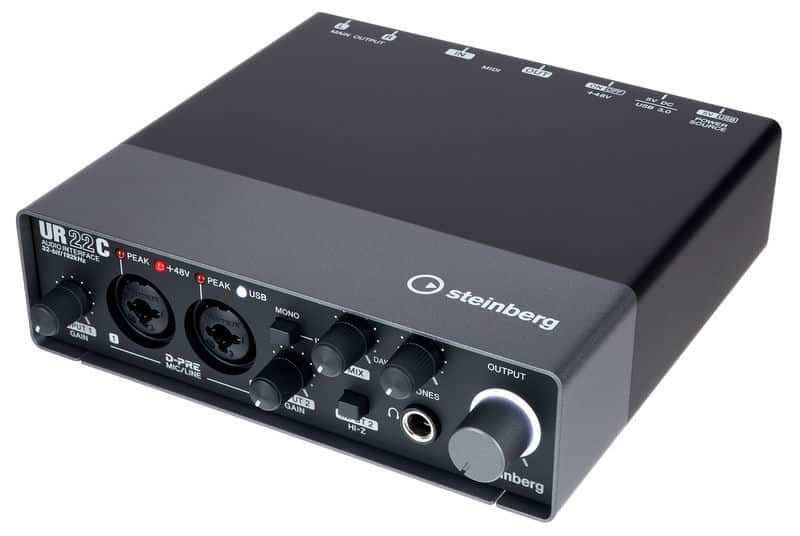
The UR22c is a 2×2 USB audio interface that features the D-Pre preamps and a whopping 32-bit/192kHz audio resolution, which is way higher than the standard 16-bit/44.1kHz that’s generally used to record music.
Input 1 is only designed to handle Mic and Line level signals while the second input can also be used to record Hi-Z Instruments, such as guitar and bass.
The UR22C features a built-in DPS chip that can be used for zero-latency monitoring while still using effects, and this is done via the dspMixFx software, which also comes included.
The effects included with the dspMixFx software are the REV-X Reverb, the Sweet Spot Morphing Channel Strip, and the Guitar Amp Classics bundle (Clean, Crunch, Drive and Lead Amps included), which allows you to record guitar using one of those Guitar amp sims without any latency whatsoever and without taxing your CPU.
Other than that, the UR22C offers 48v phantom power, a “Mono” switch that lets you hear your mix in mono, MIDI I/O, and a “Mix” knob that lets you choose how much of your PC’s playback vs how much of the direct signal you’re hearing, two ¼” TRS outputs as well as a headphone out, and a copy of Cubase AI and Cubasis LE (for iPad).
Find out more about the Steinberg UR22C here:
- Steinberg UR22C: Amazon, Sweetwater.
Solid State Logic SSL2+
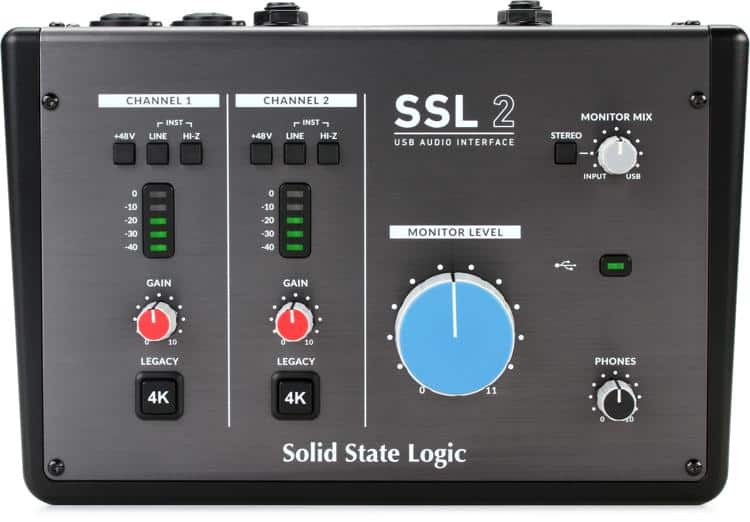
Solid State Logic has been in the recording & mixing industry for over forty years now, and they are mostly known for their high-end mixing consoled used by many top producers (Chris Lord-Alge anyone?).
The SSL 2+ features two XLR-1/4″ analog inputs with superior quality preamps and converters for mic, instrument, and line-level signals, as well as two 1/4″ TRS main outputs, two headphone outputs, and RCA Stereo out.
As far as the recording quality goes, it’s even better than the one of the Audient Interfaces, even though at that level it’s not even worth comparing since both have pro-quality preamps.
In addition to this, MIDI I/O is also available on the SSL 2+, which isn’t something that guitar players usually worry about, but if you have a MIDI controller, then you can take advantage of that.
One feature that differentiates this audio interface from all the other ones on this list, is the “4K” button.
This button emulates the sonic characteristics of the SSL 4000 series consoles with the press of a button, boosting the high-end and adding a bit of harmonic distortion (essentially it adds some brightness and opens up the sound, similar to the Focusrite Air Circuit).
Lastly, it also comes with an included software bundle from Avid, Ableton, and Native Instruments, and over 1.5GBs of samples from Loopcloud, as well as multiple audio processing plugins. Sadly, no guitar amp simulation software.
Find out more about the SSL 2+ here.
Audient iD4 & iD14 MKII
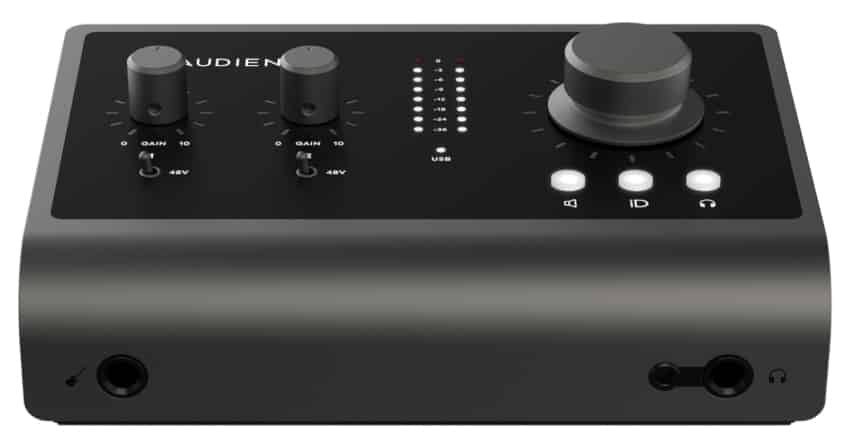
Audient is probably my favorite brand when it comes to Audio Interfaces. The preamps that come with these compact audio interfaces are the same ones that Audient puts into their high-end consoles, which sound extremely clear and warm and provide a lot of headroom.
All Audient Interfaces are built to last since they have a solid metal construction and even the knobs don’t wiggle one bit. They are just very well put together and should last you forever.
The iD4 is a 1-input Audio Interface, while the iD14 comes with two, and just like with the Sono, the channel count of the Audient iD14 can be expanded to a total of 10-inputs by using the ASP 880.
Both feature a JFET instrument input which, out of all the regular audio interfaces not strictly designed for recording electric guitars, is the one that sounded the absolute best!
Sure, you will need to use a regular amp simulation software that will introduce some latency while recording since your PC needs to process the audio, but I record that way and managed to get my latency below 5ms, which absolutely can’t be felt.
If you want an interface with great-sounding preamps, a fantastic instrument DI and at a reasonably low price, then go with either the Audient iD4 or the iD14.
Find out more about the Audient Interfaces here:
- Audient iD4: Amazon, Sweetwater.
- Audient iD14: Amazon, Sweetwater.
Focusrite Scarlett Series
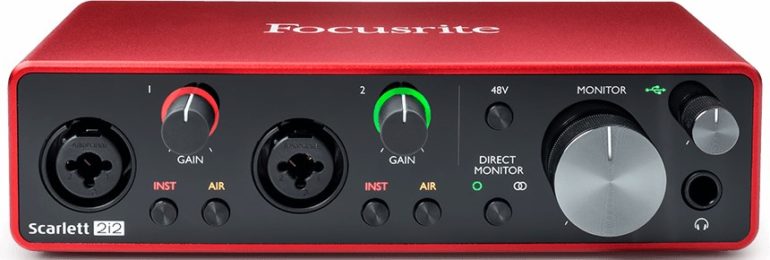
The Focusrite Scarlett series Audio Interfaces have been around for quite some time now, in fact, they are on their 3rd generation as of now. Not only are these audio interfaces highly affordable, but they have also been the best-selling ones for ages, mostly because of how cost-efficient they are.
You can get them in a variety of shapes and sizes; from a 1-channel interface (the Scarlett Solo), to a whopping 18 inputs for the Scarlett 18i20.
Depending on the model you get, you will have access to one or two instrument inputs (Hi-Z), and they sound pretty darn nice if you ask me, not as good as the JFET DI input available on the Audient interfaces but close enough, and all of this for a much lower price.
The Scarlett series don’t come with any free Guitar Amp Simulation software for you to take advantage of, but since they are so affordable you could definitely invest only about $40 into something like BIAS FX II and get a phenomenal setup for recording electric guitar.
Most bedroom producers tend to gravitate towards the Scarlett Audio Interfaces, and this is because they give you the most bang for your buck. Sure, you will get a slightly better-sounding interface if you spend five times as much and go with the Apollo Twin, but is it really worth it? Probably not.
Find out more about the Focusrite Scarlett Series here:
- Scarlett Solo: Amazon, Sweetwater.
- Scarlett 2i2: Amazon, Sweetwater.
- Scarlett 8i6: Amazon, Sweetwater.
- Scarlett 18i20: Amazon, Sweetwater.
Behringer U-Phoria Interfaces

Similar to the Focusrite Interfaces, Behringer features its own lineup of affordable Audio Interfaces that range from just 2 inputs (UMC22HD) to 18 inputs (UMC1820).
All of them feature one or two Hi-Z inputs (Instrument Inputs) as well as a different number of mic/line inputs, depending on the model, and even MIDI I/O.
Now, while it’s safe to say that both in terms of audio quality as well as build quality the UMC lineup doesn’t really compare all that well to most other interfaces on this list, their prices cannot be beaten, since you can get the UMC1820 (18 input interface) for around $200, which is half as much as it’s competitor, the Scarlett 18i20.
And even then, with how much technology has improved over the years, it will be near impossible for someone with an untrained ear to notice the difference between the preamps inside of a Behringer UMC Interface or the one inside of an Audient interface.
Additionally, these interfaces pack a whole lot of features such as MIDI I/O and free included software, which can’t be ignored.
Find out more about the Behringer UMC Audio Interfaces here:
- Behringer UMC22: Amazon, Sweetwater.
- Behringer UMC204HD: Amazon, Sweetwater.
- Behringer UMC404HD: Amazon, Sweetwater.
- Behringer UMC1820: Amazon, Sweetwater.
KOMPLETE AUDIO Interfaces
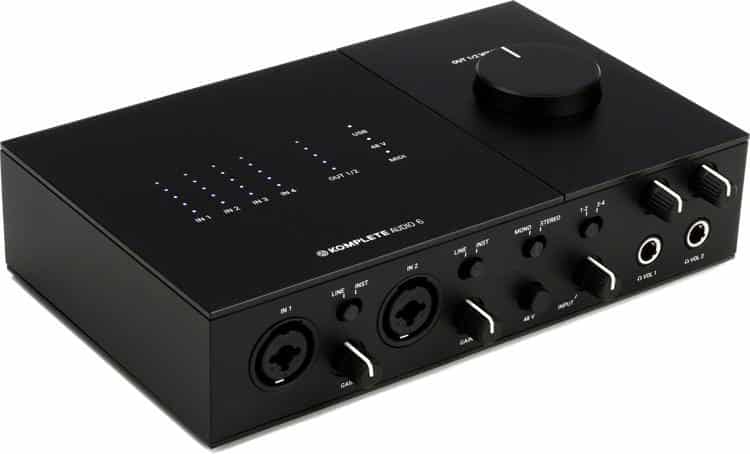
The Komplete Audio Interfaces are made by Native Instruments, one of the biggest names in the music-related software space, and they range from 1 input all the way up to 6, and depending on the model, they come with MIDI I/O and S/PDIF.
What makes these Audio Interface stand out isn’t necessarily the interfaces themselves, but rather the huge amount of software that comes included, since they come with several GB of included virtual instruments, effects, Ableton Live 10 Lite and Traktor LE 3 software, and even a $25 voucher to buy more software on their site.
Now, when these Audio Interfaces came out, you were able to get Guitar Rig Pro for free, right now it’s not the case, but if that promotion ever comes back, I think that It’s fantastic since Guitar Rig is one of the best Amp Simulation software out there, plus it costs about $150.
Find out more about the Komplete Audio Interfaces here here.
- Komplete Audio 6 MK2: Amazon, Sweetwater.
- Komplete Audio 2: Amazon, Sweetwater.
- Komplete Audio 1: Amazon, Sweetwater.
IK Multimedia iRig Stomp I/O
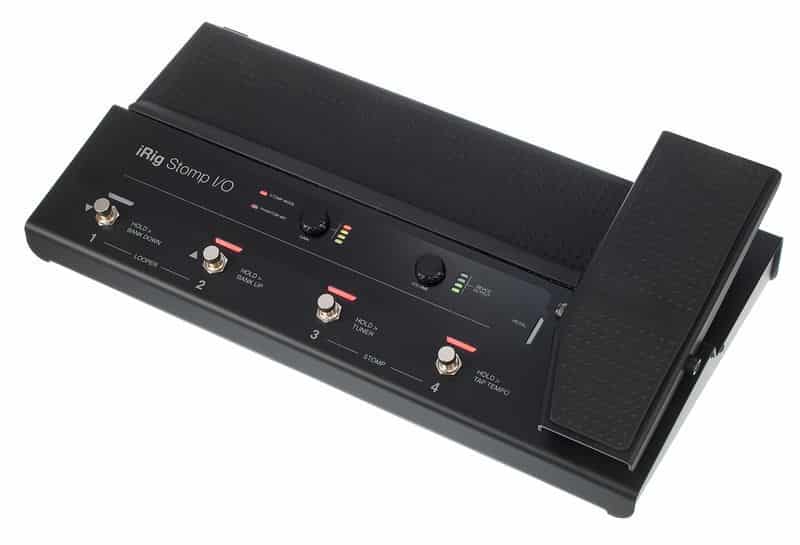
Another addition to this list by the guys at IK Multimedia is the iRig Stomp I/O, which comes in a familiar stompboard-style format and that features a regular XLR Mic/line/Hi-Z Input, as well as MIDI I/O.
You can use it as a USB pedalboard controller or an audio interface for your Mac, PC, or iOS device, and it can also work as a standalone MIDI foot controller.
What’s interesting about the Stomp I/O is the fact that it can work both as a pedalboard during live shows or while recording, and as a regular audio interface that you can use in your Home Studio, even though it doesn’t really look like one, and it seamlessly integrates with Amplitube (which comes included for free), as well as Vocal Live (also included for Free).
This one definitely has a more “hands on” approach than all the other interfaces on this list, at least for guitarists, and the fact that it integrates with Amplitube seamlessly and that it can be used live is really nice, plus you can record at home with it!
Find out more about the IK Multimedia iRig Stomp I/O here.
- IK Multimedia iRig Stomp I/O: Amazon, Sweetwater.
IK Multimedia iRig HD 2
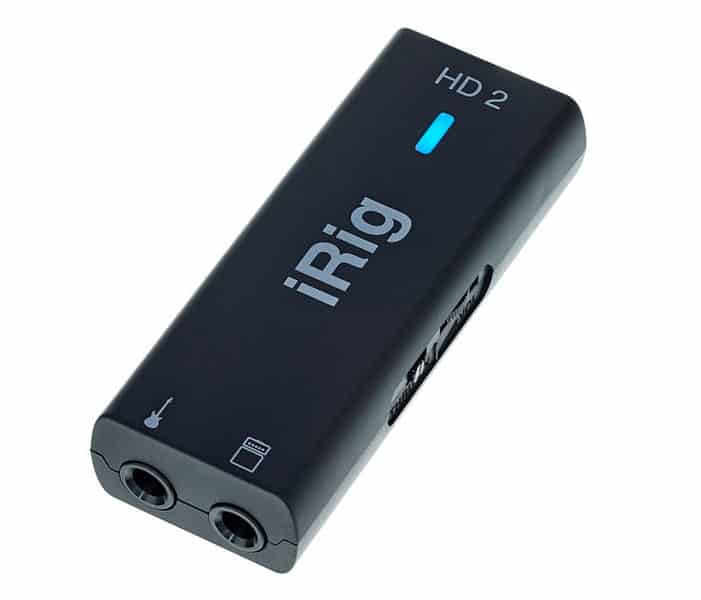
This is the successor to the world famous iRig 2 by IK Multimedia, the company that created both the amp simulation software Amplitube and the AXE I/O Audio Interface I mentioned earlier.
This handy device works both as an Audio Interface for your electric guitar and as a live tool to add effects (Stompboxes) to your signal chain directly into your amp, as well as amp simulations if you want to go straight to a mixing board.
iRig HD 2 works with Amplitube on both your PC (Windows or Mac) and any iOS Mobile Device (sadly not on Android), and you can control all the sounds directly from your phone/computer, which is actually why it can be used in a live setting since you load up Amplitube on your phone and connect the output of iRig to the input of your Guitar Amp, and that’s it! It’s really simple.
Of course, you get Amplitube with it, which already sells for the same price as the iRig HD 2.
Find out more about the IK Multimedia iRig HD 2 here:
- IK Multimedia iRig HD 2: Amazon, Sweetwater.
My Top Recommendation
Even though most of these audio interfaces have a lot to offer, I think that the top two contenders are the Audient Sono and the AXE I/O.
However, if I had to choose, I’d have to go with the Sono since it costs a lot less, plus having a real tube preamp with EQ and the ability to load cab simulations on to the interface to either record without any latency or to play live, is just fantastic!
Don’t get me wrong, the AXE I/O has a lot going for it, but the difference in price isn’t worth it in my opinion, so just go with the Audient Sono.
Conclusion
All audio interfaces on this list have their place, but I just think that the Sono has a lot more going for it than all the other ones, especially when considering the price.
If you like using amp simulation software, like Guitar Rig, then the preamp section in the Sono won’t really be that useful, so you might want to save a few bucks and go with the Audient iD14 or the Scarlett 2i2.
Anyhow, all the interfaces on this list work and sound fantastic and you really can’t go wrong with either of them.
I hope this information was useful!
Have a great day!

Hi everyone,
I’m Fab and I need your advices.
I have a boss GT-100, and I would like to know what audio interface will suit well with it in order to record and créating musics at home.
thanks to everyone who will answer, thanks.
Hi
I have the Axe IO and while it is great for guitar I use it as a general IO device. I have 2 synthesisers connected (a Korg Wavestate and a Behringer Neutron via an Arturia midi keyboard) and a Kong Volca Beats.
It works seamlessly with Ableton Live, Pigments and other software as well as the Rokit 5 G4 monitors.
I have delay, reverb and overdrive pedals in the chain also.
Overall a great piece of kit and any upgrade would be to a semi-pro item like the Presonus Soundlive series but only if I need more inputs.
Tha amp out feature is not common and works very well.